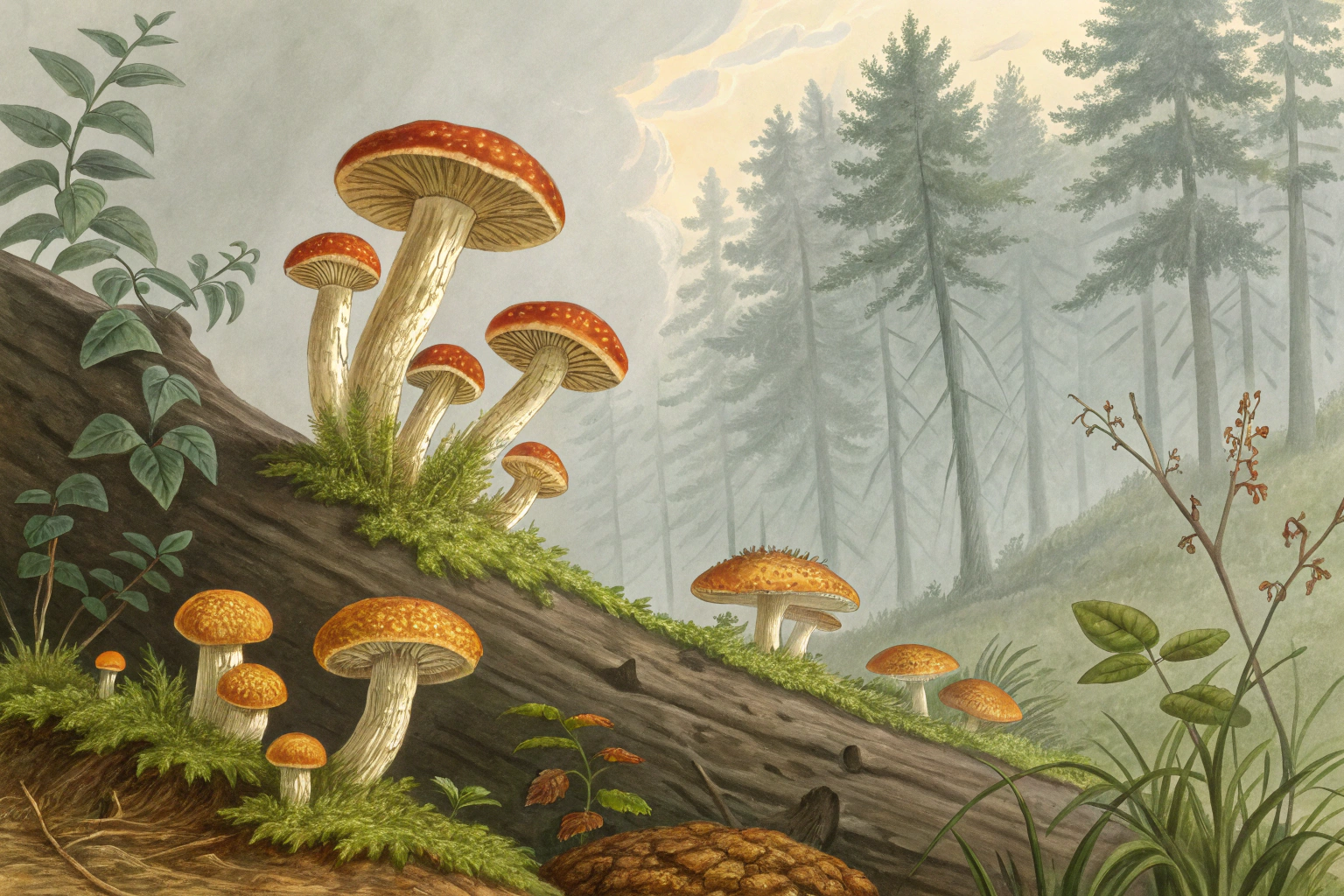Growing Shiitake Mushrooms for Rich Flavor and Quality Yield

Growing Shiitake Mushrooms
Growing Shiitake Mushrooms: inoculate oak logs in spring; expect 0.5–1 lb per flush, 2–4 flushes yearly. Growing Shiitake Mushrooms works best at 55–75°F and 85–95% humidity; shade logs and soak 12–24 hours to force fruiting. Growing Shiitake Mushrooms on fresh oak or maple logs 3–8 inches thick; drill 6–8 inch spacing, wax holes; colonize in 6–18 months. Keep reading for substrate choices, spawn tricks, and a skillet finish that hits clean, woodsy umami and a yield you can count on.
Table of Contents
- Growing Shiitake Mushrooms for Rich Flavor and Quality Yield
- Wood, timing, and spawn: the foundation
- Inoculation that sets you up for years
- Spawn run, patience, and the first flush
- Yields and realistic expectations
- Microclimate that favors flavor
- Contamination and critters
- Blocks vs logs vs kits: quick buyer’s guide
- Flavor, texture, and the chef’s pan
- Vitamin D hack that actually works
- Food safety, allergies, and good sense
- Scheduling for steady baskets
- Costs that pencil out
- Troubleshooting quick hits
- Novel crossovers with the rest of the garden
- Science and trusted guidance
- My field notes
Growing Shiitake Mushrooms for Rich Flavor and Quality Yield
I grow shiitake for the same reason I keep a cast iron pan on the stove: reliability with attitude. The caps hit the skillet and smell like browned butter, forest rain, and a hint of smoke.
If you want yield that keeps paying out, shiitake on hardwood logs or supplemented sawdust lands squarely in the sweet spot of flavor and productivity.
Wood, timing, and spawn: the foundation
Best woods: white oak, red oak, sugar maple, beech, hop hornbeam, sweetgum. Avoid conifers and deadfall.
Cut live, healthy trees in late winter while dormant, then rest the bolts 10 to 14 days so antifungal sap pressures ease.
- Log size: 3 to 7 inches diameter (8 to 18 cm), 36 to 40 inches long (90 to 100 cm).
- Moisture target: 35 to 45 percent in the wood at inoculation.
- Spawn types: plug dowels for small batches, sawdust spawn for speed and scale.
I favor sawdust spawn for tight colonization and even distribution. Plug spawn shines for workshops and kids because it’s tidy and forgiving.
Strain choice drives seasonality: warm weather fruiters 60 to 80 F (16 to 27 C), cold strains 45 to 60 F (7 to 16 C), and wide range workhorses for spring and fall.
Inoculation that sets you up for years
- Drill a diamond pattern using a 5/16 inch bit (8 mm), holes 1 inch deep (2.5 cm), 6 inches apart (15 cm), rows offset 2 inches (5 cm).
- Pack sawdust spawn with an inoculation tool or hammer in plug dowels snugly.
- Seal every hole and any cut surfaces with melted cheese wax or beeswax.
- Label strain and date on the log end with a paint marker.
I stack logs off the ground on cinder blocks or rails for airflow. Shade matters: about 75 percent, like dappled woods or under 60 to 80 percent shade cloth.
Keep them evenly moist during spawn run. I aim for steady hydration, not drenching, and I avoid sprinklers that splash soil onto bark.
Spawn run, patience, and the first flush
Colonization in logs takes 6 to 18 months depending on wood density, strain, and weather. You’ll see a white bloom at the ends and around some holes when it’s ready.
To force fruit after full colonization, soak logs 12 to 24 hours in clean water at 50 to 65 F (10 to 18 C). A cold snap or a summer thunderstorm often triggers pins even without a soak.
After a flush, rest logs 6 to 8 weeks. Logs cycle like athletes: push, recover, repeat.
Yields and realistic expectations
My oak bolts average 2 to 4 pounds of mushrooms over their life (0.9 to 1.8 kg), with 2 to 6 flushes across 3 to 5 years depending on diameter and care.
On sterilized supplemented sawdust blocks, biological efficiency often hits 75 to 125 percent, which means 0.75 to 1.25 kg of mushrooms per kg of dry substrate.
“Shiitake ranks among the top cultivated mushrooms worldwide” FAO and academic surveys consistently place it second only to Agaricus in global production. (FAO; Royse, 2014)
At farmers markets near me, fresh shiitake move at 12 to 18 USD per pound. Dried sells for several times that by weight, which softens the blow of rainy market days.
Microclimate that favors flavor
Fruiting humidity: 85 to 95 percent. I tuck logs where ferns thrive, then I mist the air if it feels like chapstick weather.
Light: indirect is perfect. Think shade under a maple, not a cave.
Temperature: pins set in the range matched to the strain. Cold strains reward fall and early spring; warm strains shine mid summer.
Contamination and critters
- Trichoderma (green mold): start with fresh hardwood, avoid soil splash, wax every wound, and give logs airflow.
- Slugs: elevate logs, set beer traps, dust a light barrier of diatomaceous earth around the rack, or use copper tape on supports.
- Squirrels: fruit high on racks, harvest fast, and accept a tithe in nut years.
- Fungus gnats on indoor blocks: improve filtration, tighten sanitation, and use sticky cards outside the grow space.
If a log looks tired, I lean it over a wood chip bed seeded with wine caps. The leftovers feed the garden and I get scarlet caps in tomato alley.
Blocks vs logs vs kits: quick buyer’s guide
- Logs outdoors: lowest input, seasonal harvests, multi year returns, rustic caps with thick cuticle and deep flavor.
- Sawdust blocks indoors: fastest turnaround, predictable cycles, needs clean prep and filtration, large caps with lighter cuticle.
- Beginner kits: pre colonized, fruit on the counter at 60 to 70 F (16 to 21 C), great for proof of concept and kids.
Trusted vendors I’ve used: Field & Forest Products, Fungi Perfecti, North Spore, and local spawn labs tied to extension programs. Order strain families that match your climate and season gaps.
Flavor, texture, and the chef’s pan
Thick caps with curled edges come from slow evaporation and cool nights. They sear like steak.
I cook shiitake hard and fast in a ripping hot pan. Butter, neutral oil, a lick of soy, then finish with a squeeze of lemon and cracked pepper.
Drying deepens aroma. I dehydrate at 110 F (43 C) until cracker dry, then jar with a desiccant pack for a year of soups and risottos.
Vitamin D hack that actually works
Lay fresh caps gills up in midday sun for 30 to 60 minutes. UV light spikes vitamin D2 dramatically without ruining texture.
“Sun exposed mushrooms can provide a day’s worth of vitamin D” USDA researchers documented large increases after short UV exposure. (USDA ARS; Phillips & Rasor, 2013)
The boost survives cooking. I do this on clear days and mark the batch with a dot on the label.
Food safety, allergies, and good sense
Sear shiitake thoroughly. Raw or undercooked caps can trigger shiitake dermatitis in sensitive people, a whip like rash linked to lentinan.
Grow away from treated lumber, heavy traffic, or contaminated soil. Logs concentrate forest, not freeway dust.
Scheduling for steady baskets
I inoculate a third of my logs each spring, a third each summer with warm strain, and a third each fall with wide range. That staggering keeps something fruiting whenever weather cooperates.
I soak only a fraction of the stack at once, then rotate. Each log rests 6 to 8 weeks between soaks to rebuild carbohydrates in the mycelium.
Costs that pencil out
- Spawn: 20 to 40 USD for enough sawdust spawn to inoculate 20 to 30 logs.
- Tools: drill with stop collar, 5/16 inch bit, wax, dauber, inoculation tool, labels: 50 to 150 USD total, reused for years.
- Shade rack: pallets and posts or a simple A frame. Keep it off soil.
One healthy oak bolt often pays itself back in two flushes at market prices. After that, it’s gravy and gravy’s friend is mushrooms.
Troubleshooting quick hits
- No pins after soaking: colonization incomplete. Wait 4 to 8 more weeks or switch to a different strain window.
- Small, cracked caps: humidity too low or sudden heat. Raise ambient moisture and shade.
- Spongy stems: too much water on caps during development. Water air and ground, not the mushrooms themselves.
- Buggy gills outdoors: harvest younger and chill fast at 34 to 38 F (1 to 3 C).
Novel crossovers with the rest of the garden
Spent shiitake logs make superb borders for lettuce beds, bleeding their minerals and slow carbon into the soil. I seed the shady side with mint or Vietnamese coriander to net more square footage of flavor.
A rain barrel overflow routed through the log rack gives free soaks after storms. I watch the barometer: a pressure drop plus soaking often sets off a flush like clockwork.
Science and trusted guidance
“Oak is the preferred substrate for shiitake due to density and longevity” Cornell Small Farms Program’s log-grown shiitake guide underlines species choice for quality and yield. (Cornell Small Farms Program)
Penn State Extension notes that well managed oak logs fruit 3 to 5 years, with larger diameter logs lasting longer. They also detail drill patterns that match the spacing above. (Penn State Extension)
University of Maine Cooperative Extension outlines moisture and shade needs for outdoor stacks and warns against inoculating compromised wood. (UMaine Extension)
For indoor blocks, commercial texts and grower reports put biological efficiency commonly in the 75 to 125 percent range on supplemented sawdust with clean technique. (Royse 2014; industry grow manuals)
My field notes
Warm strain on red oak gives me brassy flavored caps in July after a thunderhead rolls through. Cold strain on sugar maple throws dense, scalloped caps that stand up to braise.
I date, weigh, and snap a photo of each flush. The log that looks ordinary in year one sometimes becomes a legend in year three.
Cheatsheet: Shiitake Yields & Flavor in Your Garden
🍄 Select & Prepare Logs
- Use hardwood (oak, maple, beech) 3–6 in (8–15 cm) diameter, cut fresh, 3–4 ft (1–1.2 m) long
- Rest logs 2 weeks after cutting
🧰 Tools and Products You'll Need
- Shiitake spawn (plug or sawdust)
- Power drill, 5/16 in (8 mm) bit
- Wax (cheese, bees, or soy)
- Small hammer or inoculation tool
- Brush for wax application
- Gloves
🔬 Inoculate Logs
- Drill holes 6 in (15 cm) apart in rows, offset rows around log
- Insert spawn, tap in plugs or pack sawdust
- Seal holes & log ends with wax
🌳 Place & Maintain
- Stack logs in shade with airflow; avoid ground contact
- Keep logs damp, water during dry spells
- Optimal temp: 55–75°F (13–24°C)
⏳ Fruiting & Harvest
- Wait 6–12 months; tap or “shock” logs in cold water to stimulate flush
- Harvest when caps are 70–90% expanded, before edges flatten
- Expect 2–3 flushes/year, yield drops after year 4
🥗 Nutrition & Self-Sufficiency
Rich in B-vitamins, vitamin D, and fiber. Immune-supporting lentinan. Save $15/lb (€13.5/kg) vs store price.
🧊 Storage
- Keep fresh up to 2 weeks at 36–40°F (2–4°C)
- Dry or freeze for longer shelf-life
📈 Stats
- One 4 ft (1.2 m) log yields up to 1.5 lb (0.7 kg) per flush
- Log productivity: 3–5 years
Frequently Asked Questions About Cultivating Shiitake Mushrooms
What type of wood is ideal for cultivating these mushrooms?
These mushrooms thrive best on freshly cut hardwood logs. Ideal choices include oak, maple, and beech, as their dense wood structure provides essential nutrients for mushroom growth. Avoid softwoods like pine or cedar, since they contain natural resins that inhibit fungal development.
How long does it take for mushroom logs to start producing?
Typically, logs inoculated with mushroom spawn require 6 to 12 months before producing their initial crop. Patience is essential, as this waiting period allows the fungus sufficient time to colonize the wood thoroughly.
What environmental conditions encourage healthy fruiting?
For optimal mushroom harvests, maintain a shaded, humid location with consistent moisture levels. Ideal temperatures fall between 55-75°F (13-24°C), along with relative humidity levels around 70-80%. Regular moisture monitoring ensures consistent mushroom fruiting.
How often and how much water do mushroom logs need?
Logs require regular moisture but shouldn't saturate continuously. Soaking them for 12-24 hours every 6-8 weeks generally supplies sufficient hydration. Shorter soaking periods can effectively revive logs in hotter climates or drier conditions.
How many flushes can a single log produce before needing replacement?
Properly managed hardwood logs can yield multiple flushes over a lifespan of 3-5 years. Yield typically peaks around the second or third year, before gradually declining. Replacing logs periodically ensures consistent mushroom production.
Are wild animals or pests attracted to mushroom logs?
Occasionally, logs can attract insects, slugs, or small mammals due to their moisture-rich environment. Implement preventive measures by placing logs on elevated racks or stands, keeping areas well-ventilated, and conducting regular inspections.
Done right, Growing Shiitake Mushrooms is steady craft, patient work, and clean habits. Use fresh hardwood logs, oak or maple. Drill clean holes, plug with clean spawn, seal with wax. Stack in shade with airflow. Keep logs evenly moist. To fruit on cue, soak 12 to 24 hours, then let them rest 6 to 8 weeks. Pick at a firm cap, about three quarters open. Keep slugs off with tidy ground and copper, and keep tools clean.
Yield follows rhythm. Rotate stacks by age and diameter, and you will eat well from spring and fall flushes. Best range sits near 55 to 75 F. Expect first caps after colonization, often 6 to 18 months, worth every week. Keep records, cull deadwood, and feed the patch with rain and patience. For cooking, grow your own garlic and leeks to meet those smoky caps.



